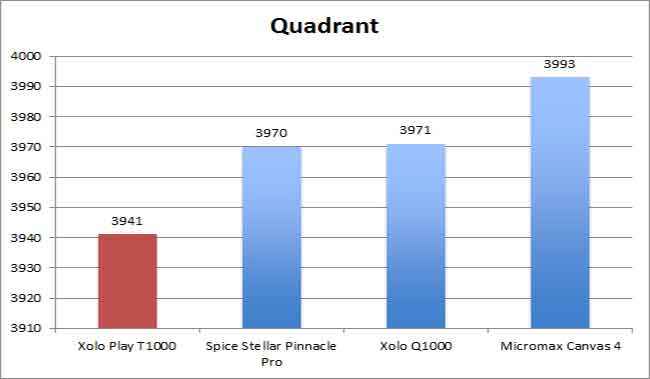Xolo Play T1000: First Impressions
The Tegra 3-powered Xolo Play T1000 has just arrived in the Digit Labs. Here are our first impressions of the smartphone.

Xolo has launched quite a few interesting budget smartphones in the past such as the Xolo Q800, Q700, A1000 and more. In the budget quad-core race dominated by MediaTek, Xolo has introduced a smartphone running on the Tegra 3 chipset – the Xolo Play T1000. Even though the world is moving towards Tegra 4, it’s nice to see the age-old powerful chipset make an appearance on a budget device. Does it deliver?
 Survey
SurveyStarting off with the specifications, the Xolo Play T1000 brings with it a 1.5GHz Tegra 3 quad-core mobile processor, with 12-core GeForce GPU along with 1GB of RAM. The smartphone has a 4.7-inch 720p IPS display and the smartphone runs on Android 4.1 Jelly Bean. This is a bit of a letdown considering that 15K smartphones today launch with Android 4.2 Jelly Bean. The rear of the device has an 8MP BSI camera with the ability to shoot video in Full HD. The front has a 2MP video-calling camera. The rear of the smartphone has the NVIDIA branding as well for you to show off.
On the Xolo Play you get 4GB built-in storage expandable up to 32GB via a microSD card. Connectivity options include 3G, Wi-Fi 802.11b/g/n, Bluetooth 3.0 and GPS/aGPS. A 2000mAh battery powers the entire package.
Since the device is powered by NVIDIA’s chipset, you have access to the TegraZone and a large library of games. You can access these games directly from the Play store as well.
 |
.jpg) |
 |
 |
Coming to the build of the Xolo Play, the device has quite a good finish. The rear has a matte rubberized finish, which adds to the grip and the overall aesthetics of the smartphone. The right has the volume rocker and the power button and they are slightly protruding which is nice and you can access the buttons without looking at the smartphone. The top has the microUSB port and the headphones jack.
 |
 |
 |
 |
Overall, the build of the Xolo Play T1000 is quite premium. Better than the Canvas 4. The size of the smartphone is at par with the Nexus 4.
 |
 |
 |
 |
Coming to the performance, since the Xolo Play just arrived in our labs we will take some time to put it through its paces, but here are our initial impressions of the device.
 |
 |
 |
 |
The Xolo Play’s interface is stock Android and that is a good thing, but the onboard keyboard is not. You have the Swype keyboard that comes preloaded on the device. It took us a bit of getting used to the new keyboard. The keys feel a bit cramped. There is a slight lag too while navigating the device.
Coming to the benchmark scores, we have updated the scores with a new unit that we received and tested. Here is a look at how the Tegra 3 powered Xolo performs against smartphones powered by the MediaTek MT6589 chipset.
 |
 |
 |
 |
 |
 |
The AnTuTu and Quadrant scores of the Xolo Play when compared to the competition are quite close. In other benchmarks, the Xolo Play scores higher than the competition although a significant difference is only in the Smartbench Productivity score. For the rest, it does score better, but marginally.
Update 1 (18/07/13): Unfortunately, the benchmark scores were fairly variable (with more than 30 percent variation in some cases). When we ran them back to back for AnTuTu and Quadrant, the scores went down after every run, probably caused by thermal management, with the CPU being throttled on reaching certain temperatures. This also probably explains the reason for the device back not getting too warm even after being put through 10-12 benchmark runs. Check out the variable AnTuTu and Quadrant benchmark scores below.
 |
 |
 |
 |
 |
In our first impressions, the Xolo Play T1000 seems interesting and well-built, but appears to fall short when it comes to raw performance. Stay tuned for our complete review where we will talk in-depth about the gaming performance of the smartphone.
Update 2 (19/07/13): After the large variations seen in running the benchmark scores, we have received a fresh review unit from Xolo. Once the unit was received, we updated the onboard apps, downloaded the benchmarks and ran them three times. In the graphs above, we have taken the average of the three scores obtained. Here is a quick look at the scores received each time.
|
Xolo Play Benchmark Scores
|
Test 1
|
Test 2
|
Test 3
|
|
Quadrant
|
4027
|
3749
|
4047
|
|
AnTuTu
|
12776
|
12245
|
12384
|
|
LinPack Benchmark (single thread) MFLOPS
|
51.4
|
41.358
|
39.638
|
|
LinPack Benchmark (multi thread) MFLOPS
|
137.687
|
127.875
|
135.584
|
|
3DMark Icestorm
|
3622
|
3617
|
3659
|
|
3DMark Icestorm Extreme
|
1985
|
1805
|
1974
|
|
GFXBench Egypt HD (on screen)
|
1688
|
1691
|
1690
|
|
GFXBench Egypt HD (off screen)
|
1195
|
1192
|
1195
|
|
SmartBench 2012 Productivity
|
4682
|
4682
|
4735
|
|
SmartBench 2012 Gaming
|
2631
|
2658
|
2659
|
|
NenaMark2 (FPS)
|
51.8
|
51.9
|
51.3
|
From the above table it is clear that the Xolo Play’s benchmark scores aren’t vastly varying as they were with the previous unit. The scores are consistent. Stay tuned, as we will bring you an in-depth review of the Xolo Play T1000 once we have thoroughly tested the smartphone.
Sameer Mitha
Sameer Mitha lives for gaming and technology is his muse. When he isn’t busy playing with gadgets or video games he delves into the world of fantasy novels. View Full Profile